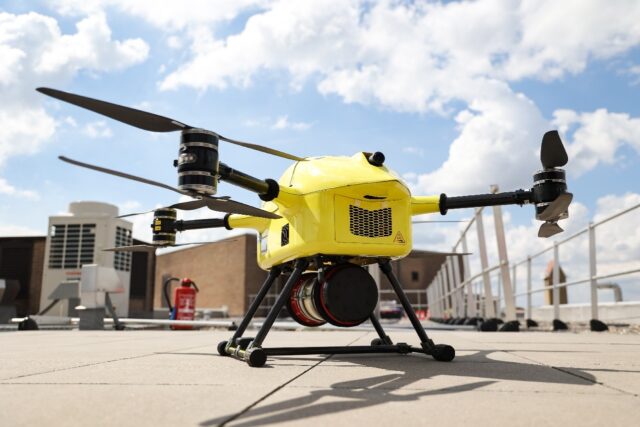Belgian hospitals have begun testing a drone to save time delivering human tissue samples across city centres, between patients on the operating table and medical labs, a first in Europe.
On Tuesday, a drone flown by a private contractor took off from an Antwerp building in the ZNA hospital group and flew 800 metres to land on the roof of the GZA group’s Sint-Augustus site.
Slung underneath the quadcopter was a sterile flask containing human tissue samples to be tested for cancer cells. The first test flight was followed by four more.
The private company Helicus is the only firm in Europe to have been granted a license to use unmanned aircraft for medical purposes, over cities and with a remote pilot out of light-on-sight.
The drone itself is manufactured by the Belgian firm SABCA, and Helicus hopes to have developed a commercial operation with regular flights by 2024.
Testing is ongoing, but the European Union is expected to adopt new rules next year that could see medical flights permitted across the 27-member bloc.
Michael Shamim, Helicus’ chief executive, told AFP that hospitals are saving costs by centralising testing labs — but then finding themselves more remote from patients.
“You need a fast logistics system. And that’s where the drones come in,” he said.
Drones are not affected by traffic delays and road closures, so their direct routes between hospital facilities are often quicker but also more predictable.
Antwerp’s two big hospital groups, ZNA and GZA, handle 1,200 tissue samples extracted during surgery per year, and these must often be analysed swiftly in order to decide the course of the operation.
Currently, samples are taken to the city’s four labs by road — sometimes by taxi.
“When removing a tumour, the surgeon tries to spare surrounding tissue as much as possible,” said pathologist Sabine Declercq.
“But to ensure the tumour has been completely removed, samples are sent to the lab during the procedure and the results must fall within thirty minutes.”
For the moment, only samples intended for analysis such as human tissue and urine are ro be carried by drones, but Helicus hopes one day to carry blood transfusions and donor organs direct to patients.

COMMENTS
Please let us know if you're having issues with commenting.